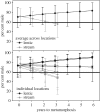Field study suggests that sex determination in sea lamprey is directly influenced by larval growth rate
- PMID: 28356456
- PMCID: PMC5378093
- DOI: 10.1098/rspb.2017.0262
Field study suggests that sex determination in sea lamprey is directly influenced by larval growth rate
Abstract
Sex determination mechanisms in fishes lie along a genetic-environmental continuum and thereby offer opportunities to understand how physiology and environment interact to determine sex. Mechanisms and ecological consequences of sex determination in fishes are primarily garnered from teleosts, with little investigation into basal fishes. We tagged and released larval sea lamprey (Petromyzon marinus) into unproductive lake and productive stream environments. Sex ratios produced from these environments were quantified by recapturing tagged individuals as adults. Sex ratios from unproductive and productive environments were initially similar. However, sex ratios soon diverged, with unproductive environments becoming increasingly male-skewed and productive environments becoming less male-skewed with time. We hypothesize that slower growth in unproductive environments contributed to the sex ratio differences by directly influencing sex determination. To the best of our knowledge, this is the first study suggesting that growth rate in a fish species directly influences sex determination; other studies have suggested that the environmental variables to which sex determination is sensitive (e.g. density, temperature) act as cues for favourable or unfavourable growth conditions. Understanding mechanisms of sex determination in lampreys may provide unique insight into the underlying principles of sex determination in other vertebrates and provide innovative approaches for their management where valued and invasive.
Keywords: condition factor; growth; lamprey; sex determination; sex ratio; sex reversal.
© 2017 The Author(s).
Figures

References
-
- Devlin RH, Nagahama Y. 2002. Sex determination and sex differentiation in fish: an overview of genetic, physiological, and environmental influences. Aquaculture 208, 191–364. (10.1016/s0044-8486(02)00057-1) - DOI
-
- Pratt TC, Threader RW. 2009. Preliminary evaluation of a large-scale American Eel conservation stocking experiment. N. Am. J. Fish. Manage. 31, 619–628. (10.1080/02755947.2011.609003) - DOI
MeSH terms
LinkOut - more resources
Full Text Sources
Other Literature Sources

